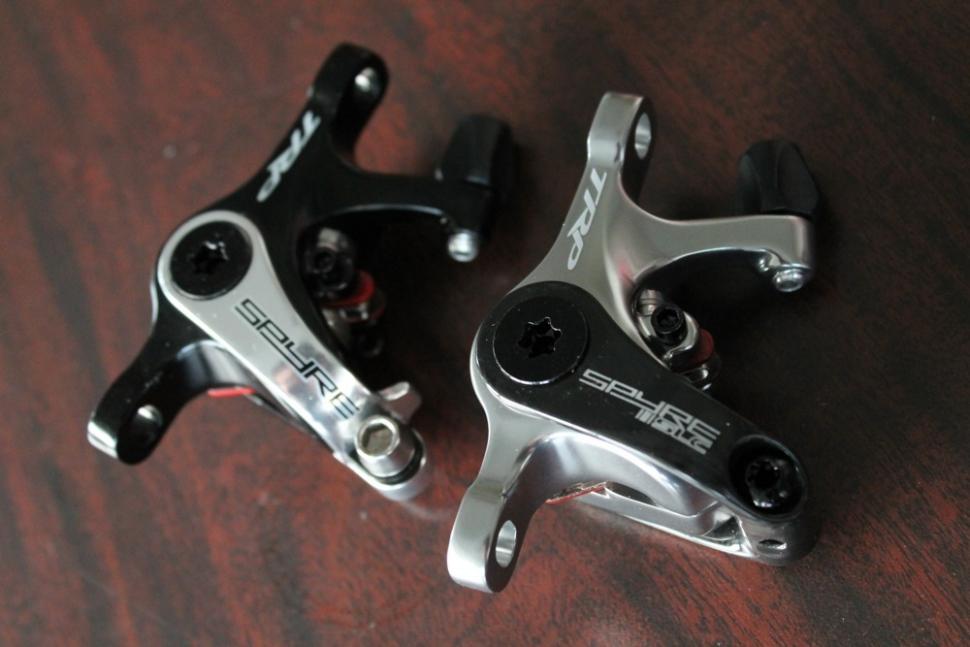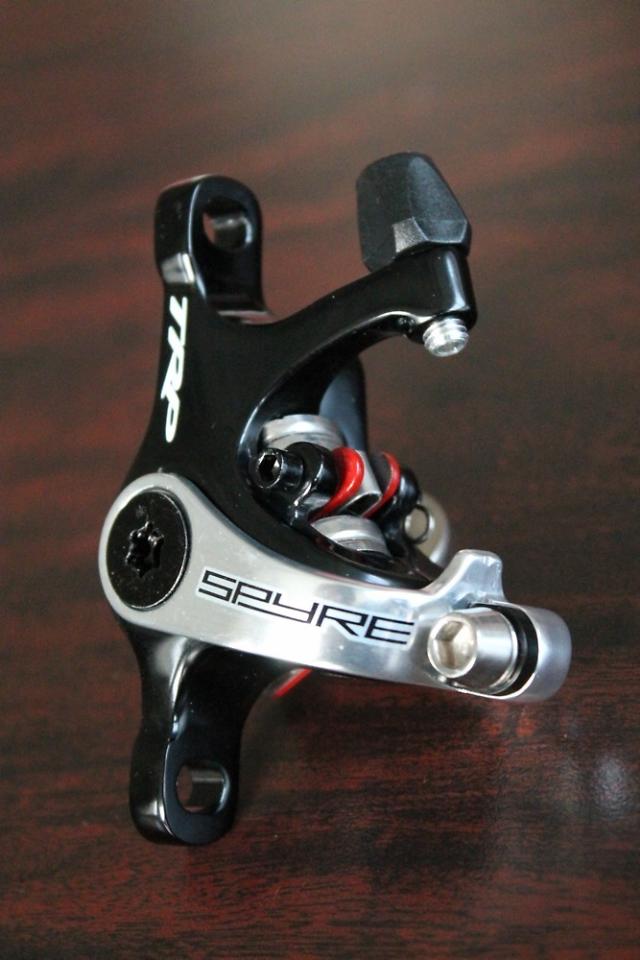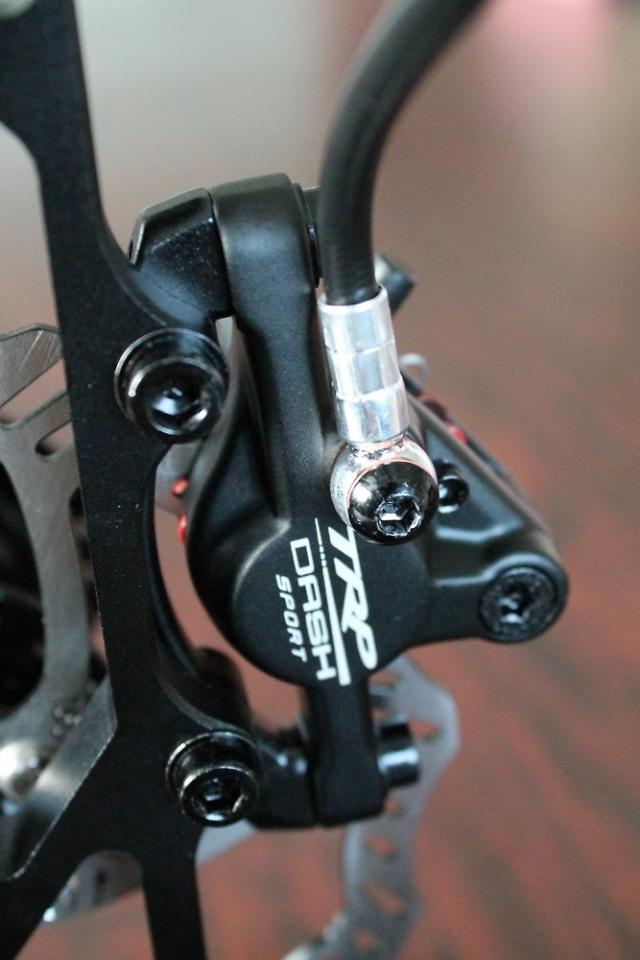- News
- Reviews
- Bikes
- Accessories
- Accessories - misc
- Computer mounts
- Bags
- Bar ends
- Bike bags & cases
- Bottle cages
- Bottles
- Cameras
- Car racks
- Child seats
- Computers
- Glasses
- GPS units
- Helmets
- Lights - front
- Lights - rear
- Lights - sets
- Locks
- Mirrors
- Mudguards
- Racks
- Pumps & CO2 inflators
- Puncture kits
- Reflectives
- Smart watches
- Stands and racks
- Trailers
- Clothing
- Components
- Bar tape & grips
- Bottom brackets
- Brake & gear cables
- Brake & STI levers
- Brake pads & spares
- Brakes
- Cassettes & freewheels
- Chains
- Chainsets & chainrings
- Derailleurs - front
- Derailleurs - rear
- Forks
- Gear levers & shifters
- Groupsets
- Handlebars & extensions
- Headsets
- Hubs
- Inner tubes
- Pedals
- Quick releases & skewers
- Saddles
- Seatposts
- Stems
- Wheels
- Tyres
- Health, fitness and nutrition
- Tools and workshop
- Miscellaneous
- Buyers Guides
- Features
- Forum
- Recommends
- Podcast
TECH NEWS
 TRP Spyre and Spyre SLC
TRP Spyre and Spyre SLCTRP launch new disc brakes at Taipei International Cycle Show:
TRP are launching two new disc brakes aimed at the road market in the shape of the Spyre and the HyRd.
We actually told you about these brakes briefly a few weeks ago when we saw them from the Core Bike Show, but now we have a lot more details having visited TRP in Taiwan earlier this week
The Spyre is a mechanical (it uses a cable rather than hydraulics) two-piston disc brake for road levers. Both of the pads move towards the disc rather than just one pad pushing the disc over to contact the other pad.

Other features include ramped ball bearings that are designed to offer smooth pad engagement and accurate modulation, and integrated barrel adjusters. These look and work like the barrel adjusters you find on a normal rim brake: you just wind the adjuster out to tension the cable and bring the pads closer together.
TRP reckon that the Spyre is 20% more powerful than Avid’s super-popular BB7 disc brake, and 40g lighter.

The Spyre brakes will actually come in two versions. The normal version will cost £69.99 per brake while a carbon-fibre model, the Spyre SLC, will be £89.99. The carbon fibre results in a minor weight advantage – 146g per wheel as opposed to 154g – but it’s largely a cosmetic thing. The weight of the 160mm rotor is 85g, according to TRP.

The other new road disc brake from TRP is the HyRd – you pronounce it ‘high road’, if you want to be one of the kool kidz. The Hy/Rd (‘high road’, don’t forget) is a mechanical interface hydraulic disc brake for road levers.
Do what? The idea is that you get the power and modulation of a hydraulic disc brake but in a cable actuated lever system. Any better? In the plainest of English, you get super-powerful braking with yer standard road levers – Shimano STI dual controls or whatever else you might be running.

Previously with TRP, you had to use their Parabox hydraulic junction to convert the cable pull from a brake lever to hydraulic power. The Parabox will stay in the TRP range but you don’t need it here because each self-contained calliper incorporates a master cylinder. TRP realise that the simplicity of this system will appeal to a lot of people and they expect sales of the Parabox to be eroded as a result. You can chalk it down as progress.
The HyRd (you know it by now, right?) hydraulic system self-adjusts for pad wear and the composite pistons are designed to isolate heat better than steel equivalents. TRP reckon there are no heat problems at all with this design.
The system weight is 195g per wheel, the rotor weighing 89g. That’s a 160mm rotor. The HyRd will be available with 140mm rotors too but we got the distinct impression that TRP like the 160mm option better.
One of the HyRd’s real strengths is the price. It’ll be £109.99 per brake. TRP are looking to dispatch the first batch of HyRds, along with the Spyres, at the end of April, meaning that they could be available in the UK as early as June.

One more new disc brake from TRP is the Dash Sport. It’s a twin piston hydraulic disc brake for mountain biking although there’s a chance people might want to use it on a flat barred road bike too.

It comes with a radial mount master cylinder and the forged aluminium alloy lever blade has adjustable reach. Each $160 brake (we don’t have a UK price yet) weighs 297g so, again, it’s very competitive. TRP see it as a Shimano XT level product and it’ll be shipped from April.

A final product we must mention is the RG957 long reach calliper brake. The RG stands for ‘road gravel’ – it’s aimed at the gravel road market although it’s just as suitable for Tarmac-going bikes with larger tyres.
The aluminium arms are forged and CNCed, the hardware is stainless steel and you get a cam-style quick release. The cartridge pad holders are CNCed too and they’re angle-adjustable so you can toe the pads in. The reach is 47-57mm and each brake weighs a claimed 167g. The price is $180 per pair.
For more info on TRP go to www.trpbrakes.com or visit UK importer Upgrade.
Mat has been in cycling media since 1996, on titles including BikeRadar, Total Bike, Total Mountain Bike, What Mountain Bike and Mountain Biking UK, and he has been editor of 220 Triathlon and Cycling Plus. Mat has been road.cc technical editor for over a decade, testing bikes, fettling the latest kit, and trying out the most up-to-the-minute clothing. He has won his category in Ironman UK 70.3 and finished on the podium in both marathons he has run. Mat is a Cambridge graduate who did a post-grad in magazine journalism, and he is a winner of the Cycling Media Award for Specialist Online Writer. Now over 50, he's riding road and gravel bikes most days for fun and fitness rather than training for competitions.
Latest Comments
- Chris RideFar 3 hours 36 min ago
I know that in independent tests on 10 and 11 speed chains, the SRAM chains always came out bottom in terms of drivetrain efficiency. Lots of...
- quiff 3 hours 42 min ago
The comparison was between two things never intended to be used on a bike.
- perce 4 hours 12 min ago
You could get knocked down at midnight and the jury would believe a driver who said the sun was in his eyes.
- Simon E 4 hours 28 min ago
We'll have to disagree. It's as ugly as f..k. You can try putting lipstick on a pig but it's always going to be a pig....
- chrisonabike 5 hours 14 sec ago
Well, send us a review when you've cycled it!...
- kingleo 5 hours 30 min ago
Two things are certain about the anti-cyclists, they are stupid and make up facts.
- KDee 5 hours 49 min ago
Funnily enough, my experience with Wahoo TCKR is that when that needed a new battery, it would also go in the bin. The battery locating tabs would...
- Backladder 6 hours 23 min ago
Since the driver used similar language it in not "likely" that he was caused harrasment alarm or distress by having it returned to him. (IANAL)
- underworld99 10 hours 13 min ago
Some more local knowledge :...
- eburtthebike 11 hours 29 min ago
“There is a road safety emergency in our region. As Mayor, I’m committed to tackling this issue."...
Add new comment
2 comments
If the cable version is 20% more powerful than a BB7 that will be plenty. Major advantage of the Hydro version is self adjusting pads, big plus point on long rides/races like the 3 Peaks CX where pad wear is an issue.
Is there an increase in power for the HyRd over the all-cable versions?